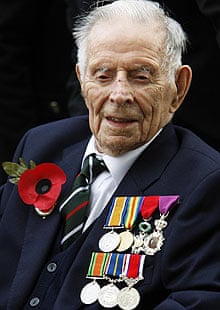Harry Patch, the last British survivor of the first world war to fight in the trenches, died today in Somerset at the age of 111.

Known as the last Tommy, Patch fought in the battle of Passchendaele in 1917 in which more than 70,000 British troops died.
He became Britain's oldest man when fellow veteran Henry Allingham, who served in the Royal Navy and the RAF, died at the age of 113 a week ago.
The sole British survivor of the first world war is now seaman Claude Choules, 108, who lives in Australia.
Gordon Brown led the tributes to Patch today, saying: "I had the honour of meeting Harry, and I share his family's grief at the passing of a great man."
The prime minister said the sacrifices of Patch's generation would never be forgotten. "We say today with still greater force: 'We will remember them'."
Close friend Jim Ross, who visited Patch regularly over many years, said he had been a peaceful man.
"Harry died peacefully, surrounded by his many friends," he said. "While the country may remember Harry as a soldier, we will remember him as a dear friend.
"He was a man of peace who used his great age and fame as the last survivor of the trenches to communicate two simple messages: remember with gratitude and respect those who served on all sides; settle disputes by discussion, not war."
Patch was a machine-gunner in the Duke of Cornwall's Light Infantry. He served in the trenches as a private from June to September 1917.
Born on 17 June 1898, he grew up in Combe Down, near Bath, and left school at the age of 15 to train as a plumber.
He was 16 when war broke out and reached 18 as conscription was being introduced. After six months' training, he was sent to the frontline.
Prince Charles paid tribute to Patch's loyalty and service during the war.
"Harry was involved in numerous bouts of heavy fighting on the frontline but amazingly remained unscathed for a while," he told the BBC.
"Tragically one night in September 1917 when in the morass in the Ypres Salient a German shrapnel shell burst overhead badly wounding Harry and killing three of his closest friends.
"In spite of the comparatively short time that he served with the Duke of Cornwall's Light Infantry, Harry always cherished the extraordinary camaraderie that the appalling conditions engendered in the battalion and remained loyal to the end."
Patch's biographer, Richard Van Emden, told the BBC his death was "an enormous loss".
"He was the last of that generation and the poignancy of that is almost overwhelming. He remembered all of those who died and suffered, and every time he was honoured he knew it was for all of those who fought."
Van Emden said his conversations with Patch as he compiled the story of his life were, "a real education".
"He had a sparkle about him, a dry sense of humour, he was just a lovely man. He was one of the most rewarding people to be with."
Fletcher House nursing home in Wells, Somerset, where Patch died, said his funeral was being arranged in accordance with his wishes.